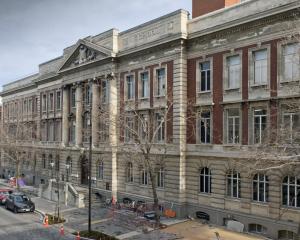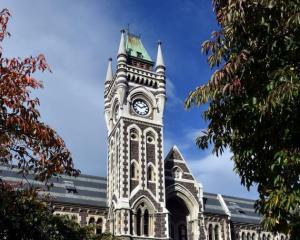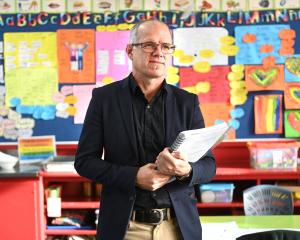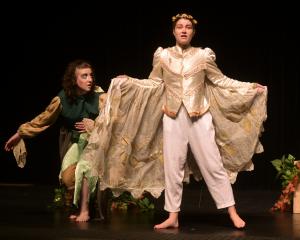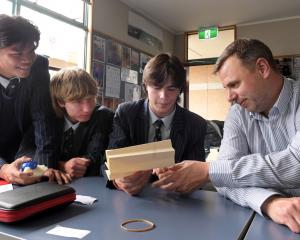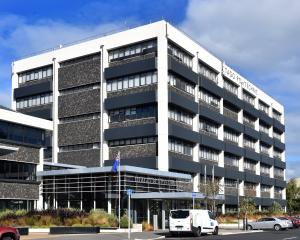On the corner of High and Alva Sts, Dunedin, at the gates of the now defunct primary school, stands a plain but peaceful stone arch.
Inscribed in lead across the top reads the words ''The Empire's Call, 1914-1918''.
This is the High Street School War Memorial, and it is one of the earliest memories from the school I attended for six years.
The arch was erected in the 1920s, and serves as a mark of remembrance for the ex-pupils who were killed in World War 1.
Their names are inscribed upon a leaded marble tablet, which remains attached to that arch to this day.
Teachers affiliated with the school were also killed in WW1.
Their names do not grace the arch, but are still recorded and remembered.
High Street School, established in 1864, was the second primary school opened in Dunedin.
It educated generations of 5-11 year olds as Dunedin grew and prospered around it, with two Olympians, a member of Parliament, and a professor of English literature at Oxford University included in its alumni.
It closed in 2011, after 147 years of educating Dunedinites.
In its early days, the school was in a prime position in the hub of Dunedin, as it bordered he main thoroughfare of the time - High St.
When war broke out in Europe in 1914, the news put a halt to the school's 50th anniversary celebrations.
The school carried on, as people and communities everywhere did, despite the fear that permeated the time, but of course, the Great War touched the students and teachers, even insulated as they were in their small school, in their small city, in their small country a world away from Europe and the fighting.
New Zealand as a whole was responding to ''the empire's call''.
Money, supplies, and, of course, people were being sent overseas, and, although New Zealand was small, it was doing all it could to aid the nation it felt part of.
The school community pulled together, and, as the first year of the war came to a close, monetary contributions from pupils enabled High Street School to purchase a single horse, for use by a member of the Otago Mounted Rifles - an accomplishment of which the children of the school were no doubt very proud.
Female pupils' sewing periods were taken up with knitting ''comforts'' for the troops, and all the children helped collect for the Belgian Fund, which supported civilians in war-torn Belgium.
During the years 1914-1918, High Street School lost 56 ex-pupils to World War 1, a number which seems shockingly large for such a small corner of the world.
Their names can be read on the still-standing arch; however, the names of the killed ex-staff cannot.
Among this latter group were William Brownlie, MA, and Archibald Henderson, DCM.
On February 17, 1924, the 60th anniversary of the year of the school's opening, a solemn unveiling of a temporary memorial tablet by two pupils took place amid more light-hearted celebrations.
The tablet was then presented to the school by Mr W F Massey, Prime Minister of New Zealand.
Massey spoke of the war effort, but the empire, especially New Zealand, and of the 17,000 New Zealanders who had died in Europe, fighting for their country, and the cause they believed in.
Today we still speak of those 17,000 men, as well as those who died in the Second World War, and in all the other wars that NZ has sent troops to.
We remember them every April 25, and we remember them when we pass memorials such as the arch outside the old grounds of High Street School.
But things have changed since 1924.
Britain is no longer an empire that calls to New Zealand.
We would likely no longer follow them so loyally into war.
We are more our own country than ever before.
Much has been made of the pointlessness and futility of the soldiers' deaths in following ''the empire's call'', and the brutal way in which they died.
Some say that we should not commemorate Anzac Day the way we do because of this.
It may be true that these men died for nothing, and that the cause they believed in was nothing but a futile death sentence for millions of people.
But that isn't the point of our remembrance.
The point is that they did die.
They died for us, New Zealand, as we were then, and as we are now.
They believed in what they were doing.
And, even if we no longer do, even if we change our flag, and sever ties with Britain permanently, it is reason enough to keep laying wreaths at dawn on Anzac Day.
World War 1 touched everyone in the four years in which it raged.
I think that High Street School tells us that, if nothing else.
It tells us that community gave money and time to donate a mount to Otago soldiers, and to Belgian refugees, and knitted things that men wore in the trenches.
And the arch tells us that people were touched in more terrible ways, Fifty-six people died on the fields of Turkey, and France, and Germany, people who had sat and learned in the old wooden school building half a world away.
Fifty-six people whose loved ones in Dunedin got letters from the army, who mourned, and cried, and whose family trees were forever blotched by the war.
The school prospered for many more years after the war, and the memory may have slipped away, if not for the arch that kept the school's history forefront in people's minds.
By typing the randomly selected name - Leslie Dawe - of one of the 56 from the High Street School arch into the Auckland War Memorial Online Cenotaph, I find his picture, and the date of his death, September 16, 1916.
He died at the Somme, aged 22.
Corporal Leslie Dawe wasn't special.
His occupation is recorded as a farm hand.
His father and mother, his next of kin, lived in St Kilda.
He walked through the gates of High Street School every morning as a child, just like I did.
Few people would have remembered him in 1924, when they wrote his name on a tablet.
Fewer, possibly none remember him today.
Perhaps no-one remembered Thomas Ireland, either, another too-young boy from the arch, who died in 1918, in France.
He's still there.
Some people remember the names of great-grandparents who died in the war.
But many names are all but forgotten. We can't memorise 17,000 names.
We don't even have the time to memorise 56.
You'll probably forget these two in an hour's time.
What can we do is remember what they did, and how they died, as the people they did it for, as the ones they left behind.
We can think about how 56 men from High Street School died, and how even the smallest communities had their punishing losses, as well as the small contributions they were proud of, like my school's horse.
Whatever we think about the war itself, and the reasons these men died, we still, 100 years later, need to remember that they did.
For New Zealand.
For us.
• By Rose McCulloch, Year 13, Kaikorai Valley College

